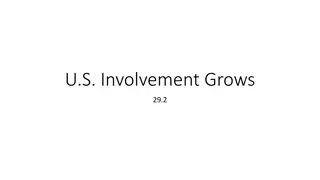The Vietnam War: Facts, Background, and US Involvement
The Vietnam War, spanning from 1955 to 1975, was a devastating conflict resulting in thousands of casualties, making it the longest war in US history. The war originated from Vietnam's complex history as a French colony, strategic US involvement due to containment policies and the domino theory, and the division of Vietnam into North and South. Key events such as the Gulf of Tonkin Resolution and the Tet Offensive further escalated the conflict, leading to a significant impact on both the local population and US forces.
Download Presentation

Please find below an Image/Link to download the presentation.
The content on the website is provided AS IS for your information and personal use only. It may not be sold, licensed, or shared on other websites without obtaining consent from the author. Download presentation by click this link. If you encounter any issues during the download, it is possible that the publisher has removed the file from their server.
E N D
Presentation Transcript
THE FOLLOWING SLIDES WILL TEACH YOU VARIOUS INFORMATION (TEXT AND IMAGES) ABOUT THE VIETNAM WAR. MEMORIZE AS MANY DETAILS AS POSSIBLE TO BE ABLE TO DO THE NEXT EXERCISE. Close your copybooks and pay attention to every single detail !
FIGURES AND FACTS November 1st, 1955 April 30th 1975 More than 58,000 killed Over 300,000 wounded and 14,000 disabled Longest war in U.S. history
BACKGROUND OF THE WAR Vietnam: French colony invaded by the Japanese during World War 2 1945 = The French returned to control Vietnam Ho Chi Minh, communist leader of the Vietnamese controlled North Vietnam and was sent aid by China France was sent aid by the US
REASONS FOR U.S. INVOLVEMENT President Truman s policy of containment : resist expansion of communism around the world President Eisenhower s domino theory belief that if a country fell to communism, neighbouring countries would fall too
A DIVIDED VIETNAM July 1954: Geneva Accords = Vietnam divided near the 17th parallel into 2 separate nations North Vietnam South Vietnam Communist regime led by Ho Chi Minh led by Ngo Dinh Diem, placed into office by the U.S. Ngo Dinh Diem was a Catholic who wanted to restrict Buddhist practices across South Vietnam
A FOCUS ON THE 1960S 1964: North Vietnamese forces attacked US Navy ships in the Gulf of Tonkin Gulf of Tonkin Resolution, which gave President Johnson authorization to use military forces in Vietnam without a formal declaration of war by Congress 400,000 U.S. troops in Vietnam by the end of 1966 President Lyndon Baines Johnson signing the resolution on August 10, 1964
1968: the North Vietnamese Army and the Viet Cong (nationalistic and communist liberation front in South Vietnam) launched the Tet Offensive, attacking nearly 30 U.S. targets and dozens of other cities in South Vietnam all at once defeat for the U.S.
1968: My Lai Massacre = frustrated U.S. soldiers killed hundreds of unarmed Vietnamese civilians in a small village
THE ANTI-WAR MOVEMENT It gained momentum as student protesters, countercultural hippies and many mainstream Americans opposed the war Associated with draft resistence and draft evasion (draft = enr lement): civilians refused to be sent to war or stay on the battlefield. Demonstrators burning draft cards
AFTER THE 1960S President Nixon promoted vietnamization of the war, promising to withdraw U.S. troops gradually and hand over the management of the war effort to the South Vietnamese Cease-fire signed in January 1973: the last U.S. troops left in March 1973 President Richard Nixon explaining the concept of vietnamization of the war
EFFECTS OF THE WAR The war is considered a traumatizing defeat in the U.S. history Americans began to distrust and question the government The War Powers Act was enacted in 1973 : the U.S. President can t send troops anywhere without the Congress s approval























